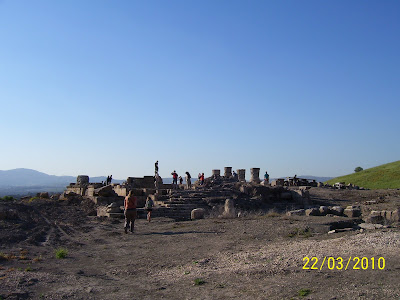




We boarded our bus at Jaffa Gate and headed out at 7:30am on Saturday, heading northwest to the Coastal Plain & Sharon Plain. Dr. Wright had to return to the states as his dad is ill, & Cyndi Parker took up his mantle with the "Physical Settings" field study . . . she did a good job! We took sooooooooooooooo many photos, but posted the best representative of each site. We still haven't had success putting captions on the individual photos, so you'll have to do the work! I made several posts for this trip, trying to put photos & related text on the same page . . .
Our first stop was Caesarea Maritime, Herod the Great's magnificent palace site on the Mediterranean. I'm not sure I've personally seen anything more beautiful! It has been one of the highlights of my trip thus far. He built it in 28 BC in honor of his beloved Ceasar Augustus and it was a challenge of nature, jutting out into the Med. But we're finding out that Herod liked challenges! The hippodrome (open air stadium for horse & chariot racing), a portion of the aqueduct (photo of Nat on top), and theater still remain through preservation. The theater still has concerts. I would love to go to one, listening & watching the sun set over the Med, but haven't found the schedule of events yet. A portion of the incredible harbor remains, and a dive shop is available for anyone wanting to see the underwater antiquities.
It was from Caesarea Maritime that a Roman Centurion, Cornelius, saw a vision that told him to send for Simon Peter (Acts 10). After Peter's arrival, Cornelius and his family became the first New Testament Gentile converts to the Gospel. The apostle Paul became a Roman prisoner after a riot against what he taught broke out in Jerusalem. When a plot to ambush and kill Paul was discovered he was immediately taken, under Roman protection, to Caesarea (Acts 21-23). Soon after his arrival in Caesarea. Paul's case was heard by Roman governor Felix. The governor, however, kept Paul a prisoner in the city for two years in the hope that money would be offered to secure his release (Acts 24:26-27). It was only after Felix was replaced as governor, and Paul requested that Caesar himself hear his case, that he left the city.
I wanted to stay, but we then traveled northeast through the Carmel mountain range to Mt Carmel & the Jezreel Valley (Yizre'el). From every vantage on this trip, we could see Mt. Gilboa, Mt. Moreh & Mt. Tabor. We could see Megiddo in the distance and TransJordan beyond. Periodically, we could see snowcapped Mt. Hermon as we travelled to the Golan Heights.













































